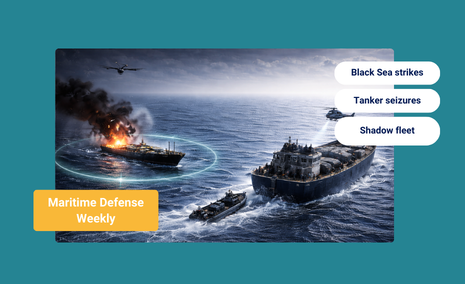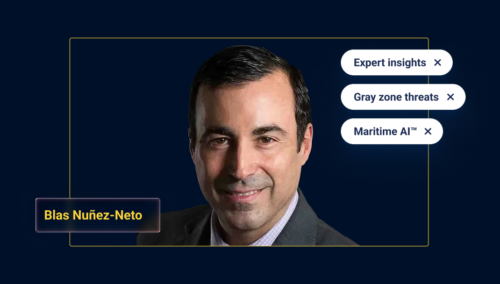Reports
UPDATED: Illuminating Russia’s Shadow Fleet
What’s inside?
This is notable for a few reasons: first, it is interesting that there is close spread of dark and gray vessels. And although 10 percent of potentially questionable vessels (some of the gray fleet vessel behavior is technically legal, hence the “gray” designation) is certainly concerning for the global maritime community, it is important to note that a whopping 75 percent of vessels come from the cleared fleet.
When we originally released this report much earlier in the war, the cleared fleet number was 82 percent. That’s a significant decrease in vessels that can be legitimate trading partners and highlights the importance of actionable visibility into a volatile and highly adaptive situation.
Organizations with the proper maritime technology can continue to quickly clear maritime trades and keep the supply chain moving.
Age Distribution
Older vessels comprise a substantial percentage of gray and dark fleet vessels. They were clearly repurposed into the risky fleet after Russia’s war against Ukraine started. A recent Vox article noted:
“But the shadow fleet has created a booming market for old tankers, including many that are over 20 years old. The average age of tankers departing the Russian Baltic Sea port of Kaliningrad is now close to 30 years old. That makes it more likely that the ships have fallen into poor conditions and makes them more prone to accidents..”
Wet Cargo Subclass Composition
Windward’s Maritime AI™ technology identified the following subclasses (in order of prevalence):
The top three dark subclasses:
- 43% crude oil tankers
- 32% oil products tankers
- 14% oil/chemical tankers
The top three gray subclasses:
- 44% oil products tankers
- 31% crude oil tankers
- 18% oil/chemical tankers
There has been an increase in the percentage of oil products tankers since our first issuing of this report that may be connected to the oil products sanctions that have since emerged.
Flag Distribution for Dark Fleet Vessels
The top five flags of dark fleet vessels are Panama, Liberia, Marshall Islands, Russia, and Malta (an EU country). Unsurprisingly, four of those countries are on the flags of convenience list and the fifth is Russia.
Additional insights:
- 12 percent of dark fleet vessels are sailing under a European flag
- 5 percent – Iran flag (increase of 4% from our last report)
- 5.6% – Gabon flag, the new popular flag of convenience in the industry
- 0.7 percent – Venezuela flag
Not many of the dark fleet vessels are flying Iranian or Venezuelan flags, seeming to indicate that these efforts are not on their behalf (or that they have gotten good at covering up such efforts over the years). It’s significant that 12 percent are sailing under a European flag (although again, Malta’s flag is a flag of convenience). Is this a sign that the European’s coalition resolve is weakening, or perhaps an indication that some members are less resolute behind the scenes than they are publicly?
Flag Distribution for Gray Fleet Vessels
While the top five flags for gray fleet vessels remained the same as in our last report earlier in the war, the numbers within the top five have greatly shifted. As of March 2023, the leading flag for gray fleet vessels is the Panama flag (last report, it was ranked fifth). Another interesting thing to note is the fact that Russia was #1 in our last report, and has now dropped to #3.
Additional insights:
- 10 percent of gray fleet vessels are sailing under a European flag (decreased since our last report, but the phenomenon still exists)
- 5.5% of gray fleet vessels fly the Gabon flag, which also made a grand entrance into the gray fleet in the past couple of months
- No gray fleet vessels are currently sailing under the Iranian flag
The European percentage is perhaps notable and worthy of further investigation.
Owner Registration of Dark and Gray Fleets by Company Location
Additional data:
- Gray fleet – 37.5% are located in Europe (an increase of 6% since March 2023)
- Dark fleet – 31% are located in Europe (an increase of 11% since March 2023)
Barrels per Day (BPD) Moved Using the Dark and Gray Fleets
Looking at the numbers in the context of Russian oil, there is a 111 percent increase in the monthly average of Russian crude oil barrels per day (BPD) carried by the gray fleet after the war. The trend was similar for oil product barrels, with a 69% increase in the monthly average when compared to pre-invasion numbers. There was a big increase in crude oil prices after the war began, with a peak in May 2023 (this correlates to the peak shown in this graph).
There was a 22 percent increase in the monthly average of BPD carried by the dark fleet after the start of the war.
According to the Atlantic Council: “In the second quarter of 2023, Urals oil prices rebounded to $55–58 per barrel. They exceeded $60 per barrel in July 2023 and reached $80 per barrel in September 2023. Overall, Asian price discounts for Urals oil have been reduced to $10–12 per barrel. Since November 2023, after the US Government has exerted some sanctions enforcement pressure on oil shippers and traders, discounts for Russian oil shipped to Asia grew again – they now stand at about $17 per barrel, but the average price of the Russian Urals oil export crude was around $68 per barrel in April 2024, well above the G7 oil price cap.”
The dark fleet is practically unchanged by the war. While the months directly after the invasion showed a 24% and a 17% increase for the monthly average of Russian crude oil and oil products (respectively) BPD, the past 12 months (April 2023-2024)) actually showed a small decrease. This minor shift indicates that the gray fleet took most of the load.
When we look at the global (not Russian-specific) amount of BPD carried by the dark fleet in the past two years, the data indicates a general decrease in the volume of oil, unrelated to Russia. However,pre-invasion Russian crude oil made up 17% of all oil carried by the dark fleet. In the past year, it increased to 21%.
The total amount of Russian crude and oil products carried by both the dark and gray fleets since the war began is +142 million BPD. With an annual average price of $77 USD per barrel of crude oil in 2023, the crude oil carried by these fleets is worth more than approximately 6 billion USD, assuming they circumvented the 60$ USD price cap.
A deeper look:
- The top three destinations – India (+1M BPD), China (+700K BPD), and Turkey (+430K BPD)
- Since March 2023, the amount of gray fleet Russian oil that arrived in India grew by 71%, Singapore by 69%, and UAE by 105%!
- New gray fleet destinations have emerged since March 2023: Saudi Arabia, Libya, Brazil, Taiwan, and Malaysia
- On the other hand, some leading destinations have completely disappeared since March 2023 – Italy, Belgium, Greece, Netherlands, and Egypt.
- This is an indication that EU sanctions package affected the destinations
Dark Fleet Top 10 Destinations
- Top three destinations – China (+800K BPD), India (+780K BPD), and Turkey (+240K BPD)
- The amount of Russian oil carried by the dark fleet that arrived to China since March 2023 increased by 73%, to India by 76%, and to Turkey by 85%
- The amount of dark fleet Russian oil arriving at the Netherlands decreased by 82% – together with Italy, Germany and Greece who also disappeared as leading destinations – another indication that EU regulations are working.)






